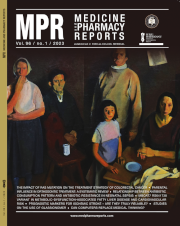Relationship between antibiotic consumption pattern and antibiotic resistance in neonatal sepsis
DOI:
https://doi.org/10.15386/mpr-2409Keywords:
neonatal sepsis, culture positive, antibiotic, defined daily dose (DDD), microbial drug resistanceAbstract
Background and aim. Inappropriate use of antibiotics may increase antimicrobial resistance (AMR) among different microorganisms and may lead to treatment failure in neonatal septicemia. The aim of this study was to recognize the most common microorganisms responsible for neonatal sepsis and to evaluate the trend of change of resistance pattern among microorganisms.
Methods. This study was done retrospectively on 344 cases diagnosed with neonatal sepsis, including both early and late onset cases, admitted to the tertiary care teaching hospital of southern India from January 2012 to July 2017. Accordingly, 231 culture positive neonatal sepsis cases were collected from hospital data base and analyzed. Culture positive cases within 72 hours of life were termed as early onset while after 72 hours were late onset. Antibiotics utilization during the period was calculated using WHO AMC tool and reported as (DDD)/100 bed days.
Results. Klebsiella pneumoniae with 56 (21.8%) and Coagulase negative Staphylococcus with 52 (20.2%) cases were the most frequent isolated organisms which were responsible for 55.8% and 14.6% of deaths among the study subjects respectively. Amikacin (86.7%), vancomycin (52.3%) and ampicillin (40.6%) were the most used antibiotics in terms of DDD/100 bed days.
Conclusion. The results obtained from our study have brought substantial information on the antibiotic resistance pattern among microorganisms causing neonatal sepsis. Moreover, results obtained from this study can be used for designing antibiotic stewardship policies to prevent the emergence of resistance and to improve the treatment outcome.
Downloads
Published
How to Cite
Issue
Section
License
The authors are required to transfer the copyright of the published paper to the journal. This is done by agreeing to sign the Copyright Assignment Form. Whenever the case, authors are also required to send permissions to reproduce material (such as illustrations) from the copyright holder.

The papers published in the journal are licensed under a Creative Commons Attribution-NonCommercial-NoDerivatives 4.0 International License.

